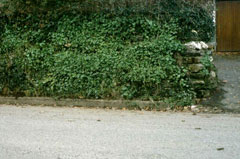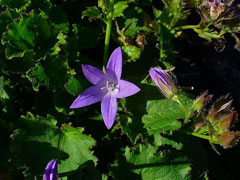 |
|
(c) 2010 Ken Fern & Plants For A Future |
 |
| http://commons.wikimedia.org/wiki/File:Campanula_poscharskyana_003.JPG |
Translate this page:
Summary
Physical Characteristics

 Campanula poscharskyana is an evergreen Perennial growing to 0.3 m (1ft) by 1 m (3ft 3in) at a fast rate.
Campanula poscharskyana is an evergreen Perennial growing to 0.3 m (1ft) by 1 m (3ft 3in) at a fast rate.
See above for USDA hardiness. It is hardy to UK zone 3 and is not frost tender. It is in leaf all year, in flower from July to September. The species is hermaphrodite (has both male and female organs) and is pollinated by Bees, flies, beetles, Lepidoptera (Moths & Butterflies). The plant is self-fertile.
Suitable for: light (sandy) and medium (loamy) soils, prefers well-drained soil and can grow in nutritionally poor soil. Suitable pH: neutral and basic (mildly alkaline) soils. It can grow in semi-shade (light woodland) or no shade. It prefers moist soil.
UK Hardiness Map
US Hardiness Map
Synonyms
Plant Habitats
Woodland Garden Dappled Shade; Ground Cover; East Wall. In. South Wall. In. West Wall. In.
Edible Uses
Edible Parts: Flowers Leaves
Edible Uses:
Leaves - raw or cooked[K]. A pleasant sweet flavour but the leaves are a little tough[K]. It makes a very addition to mixed salads in the winter, though we tend not to eat it much at other times of the year when there are more leaves available[K]. Flowers - raw. Produced in abundance, they have a pleasant sweet flavour and make a decorative addition to the salad bowl[K].
References More on Edible Uses
Medicinal Uses
Plants For A Future can not take any responsibility for any adverse effects from the use of plants. Always seek advice from a professional before using a plant medicinally.
None known
References More on Medicinal Uses
The Bookshop: Edible Plant Books
Our Latest books on Perennial Plants For Food Forests and Permaculture Gardens in paperback or digital formats.

Edible Tropical Plants
Food Forest Plants for Hotter Conditions: 250+ Plants For Tropical Food Forests & Permaculture Gardens.
More

Edible Temperate Plants
Plants for Your Food Forest: 500 Plants for Temperate Food Forests & Permaculture Gardens.
More

More Books
PFAF have eight books available in paperback and digital formats. Browse the shop for more information.
Shop Now
Other Uses
A rampantly spreading plant, suitable for ground cover in a sunny position[187, 197, 208].
Special Uses
Ground cover
References More on Other Uses
Cultivation details
Prefers a moist but well-drained rich sandy loam and a neutral or alkaline soil in full sun though it also tolerates partial shade[1, 200, 208]. We have seen plants doing very well on a north-west-facing wall[K]. Plants are very drought-tolerant and can be grown on a dry stone wall[200], they also succeed in poor soils[221]. Plants are hardy to at least -15°c[200]. A rampant spreading plant[188], it makes an excellent ground cover but can become a nuisance if it isn't sited with care[200]. The species in this genus do not often hybridize and so seed can generally be relied upon to come true[221]. The plants are self-fertile[221]. This species does not produce seed very freely in Britain, but it is very easily propagated by division[221]. There are several named forms selected for their ornamental value[200]. The form 'E.K.Toogood' is less invasive[197]. Members of this genus are rarely if ever troubled by browsing deer[233].
References Carbon Farming Information and Carbon Sequestration Information
Temperature Converter
Type a value in the Celsius field to convert the value to Fahrenheit:
Fahrenheit:
The PFAF Bookshop
Plants For A Future have a number of books available in paperback and digital form. Book titles include Edible Plants, Edible Perennials, Edible Trees,Edible Shrubs, Woodland Gardening, and Temperate Food Forest Plants. Our new book is Food Forest Plants For Hotter Conditions (Tropical and Sub-Tropical).
Shop Now
Plant Propagation
Seed - surface sow spring in a cold frame. The seed usually germinates in 2 - 4 weeks at 18°c[138]. When they are large enough to handle, prick the seedlings out into individual pots and grow them on in a cold frame for at least their first winter. Plant them out into their permanent positions in late spring or early summer, after the last expected frosts. Basal cuttings in spring[1]. Harvest the shoots when they are about 10 - 15cm long with plenty of underground stem. Pot them up into individual pots and keep them in light shade in a cold frame or greenhouse until they are rooting well. Plant them out in the summer. Division in spring or autumn[200]. Very easy, the plant can be divided at almost any time of the year[221].
Other Names
If available other names are mentioned here
Native Range
EUROPE: Croatia, Montenegro (west)
Weed Potential
Right plant wrong place. We are currently updating this section.
Please note that a plant may be invasive in one area but may not in your area so it's worth checking.
Conservation Status
IUCN Red List of Threatened Plants Status :

| Related Plants
|
| Latin Name | Common Name | Habit | Height | Hardiness | Growth | Soil | Shade | Moisture | Edible | Medicinal | Other |
| Adenophora denticulata | | Perennial | 0.5 |
6-9
| | LM | N | M | 2 | 0 | |
| Adenophora divaricata | | Perennial | 1.0 |
-
| | LM | N | M | 2 | 0 | |
| Adenophora lamarkii | | Perennial | 0.6 |
5-9
| | LM | N | M | 2 | 0 | |
| Adenophora latifolia | | Perennial | 0.5 |
-
| | LM | N | M | 2 | 0 | |
| Adenophora liliifolia | Ladybells, Lilyleaf | Perennial | 0.5 |
3-8
| M | LM | N | M | 2 | 0 | |
| Adenophora nikoensis | | Perennial | 0.3 |
5-9
| | LM | N | M | 2 | 0 | |
| Adenophora remotiflora | | Perennial | 1.0 |
5-9
| | LM | N | M | 2 | 1 | |
| Adenophora stricta | Sha Shen, Ladybells | Perennial | 1.0 |
7-9
| | LM | N | M | 2 | 1 | |
| Adenophora triphylla | Nan Sha Shen | Perennial | 1.0 |
6-9
| | LM | N | M | 2 | 1 | |
| Adenophora verticillata | | Perennial | 1.0 |
6-9
| | LM | SN | M | 2 | 2 | |
| Agapanthus campanulatus | | Bulb | 0.6 |
6-9
| | LM | SN | M | 0 | 1 | |
| Asyneuma pulchellum | | Perennial | 0.0 |
-
| | LMH | SN | M | 0 | 0 | 2 |
| Asyneuma salignum | | Perennial | 0.0 |
-
| | LMH | SN | M | 0 | 0 | 2 |
| Azorina vidalii | | Shrub | 0.3 |
8-11
| | LM | N | DM | 3 | 0 | 0 |
| Campanula alliariifolia | Cornish Bellflower | Perennial | 0.7 |
3-7
| M | LM | SN | M | 3 | 0 | 3 |
| Campanula carpatica | Tussock Bellflower, Carpathian Bellflower, Carpathian Harebell | Perennial | 0.3 |
3-8
| S | LM | SN | M | 3 | 0 | 2 |
| Campanula carpatica turbinata | | Perennial | 0.3 |
3-7
| | LM | N | M | 3 | 0 | 2 |
| Campanula cochleariifolia | Fairies Thimbles | Perennial | 0.2 |
5-9
| | LM | N | M | 4 | 0 | |
| Campanula edulis | | Perennial | 0.2 |
-
| | LM | SN | M | 2 | 0 | |
| Campanula fenestrellata | Adriatic Bellflower | Perennial | 0.2 |
5-9
| M | LM | SN | M | 4 | 0 | |
| Campanula garganica | Adriatic Bellflower | Perennial | 0.2 |
4-8
| | LM | N | M | 3 | 0 | |
| Campanula glomerata | Clustered Bellflower, Dane's blood, Clustered Bellflower | Perennial | 1.0 |
4-9
| M | LM | SN | M | 4 | 0 | |
| Campanula lactiflora | Milky Bellflower | Perennial | 1.0 |
4-8
| | LM | SN | M | 3 | 0 | |
| Campanula lasiocarpa | Mountain harebell | Perennial | 0.2 |
4-8
| | L | N | M | 2 | 0 | |
| Campanula latifolia | Large Campanula, Giant bellflower | Perennial | 1.5 |
3-7
| | LM | FS | DM | 3 | 1 | |
| Campanula latiloba | | Perennial | 0.9 |
3-7
| M | LM | SN | M | 3 | 0 | 3 |
| Campanula medium | Canterbury Bells, Cup and Saucer, Canterbury Bells | Biennial | 1.2 |
6-8
| M | LM | SN | M | 2 | 0 | 1 |
| Campanula parryi | Parry's Bellflower, Idaho bellflower | Perennial | 0.3 |
3-7
| F | LM | SN | M | 2 | 1 | 2 |
| Campanula persicifolia | Harebell, Peachleaf bellflower | Perennial | 1.0 |
3-7
| | LM | SN | M | 4 | 0 | |
| Campanula portenschlagiana | Adria Bellflower | Perennial | 0.3 |
3-7
| F | LM | SN | M | 3 | 0 | 3 |
|
|
Growth: S = slow M = medium F = fast. Soil: L = light (sandy) M = medium H = heavy (clay). pH: A = acid N = neutral B = basic (alkaline). Shade: F = full shade S = semi-shade N = no shade. Moisture: D = dry M = Moist We = wet Wa = water.
Now available:
Food Forest Plants for Mediterranean Conditions
350+ Perennial Plants For Mediterranean and Drier Food Forests and Permaculture Gardens.
[Paperback and eBook]
This is the third in Plants For A Future's series of plant guides for food forests tailored to
specific climate zones. Following volumes on temperate and tropical ecosystems, this book focuses
on species suited to Mediterranean conditions—regions with hot, dry summers and cool, wet winters,
often facing the added challenge of climate change.
Read More
Expert comment
Author
Degen.
Botanical References
200
Links / References
For a list of references used on this page please go here
Readers comment